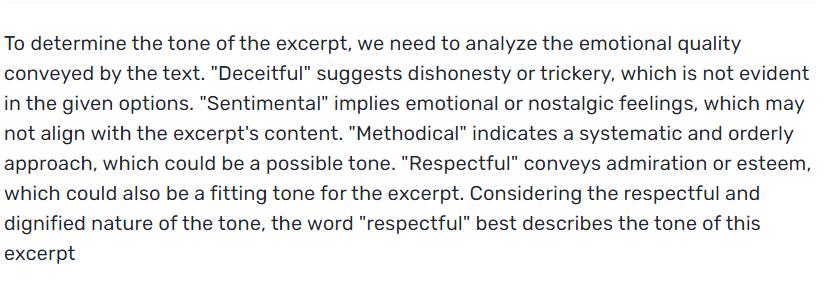The tone of an excerpt plays an imperative part in passing the maker’s mindset and close-on-to-home nuances, giving significance and significance past the severe words. When analyzing literature, critiquing a piece of writing, or just trying to understand the essence of a passage, accurately describing the tone can significantly improve your comprehension and appreciation of the work.
Understanding tone assists you with fathoming the creator’s fundamental feelings and perspectives. You can identify and describe which word best describes the tone of this excerpt? deceitful sentimental methodical respectful, using this step-by-step guide, allowing you to delve deeper into the author’s message and the emotional landscape of the text.
Step-by-Step Guide to Describing Tone
Here is the step-by-step guide to describe the tone of an excerpt:
Totally Read the Excerpt
First, read the excerpt several times. The principal read ought to be to figure out the general substance and setting. The style and language nuances should be the primary focus of any subsequent readings. Consider the feelings and attitudes that appear to underlie the text.
Recognize Catchphrases and Expressions
Look for a few standout words and phrases. The tone is frequently strongly indicated by adjectives, verbs, and adverbs. Words like exhilarating, melancholy, harsh, and gentle can, for instance, directly reflect the tone.
Analyze Sentence Structure and Punctuation
Tone can be significantly influenced by the structure and punctuation of sentences. Long, flowing sentences can convey a more relaxed or reflective tone, while short, abrupt sentences can create a tense or urgent tone.
Identify Non-literal Language
These details add depth and may reveal the author’s mentality. The personification used in the phrase, The sun smiled down on the children playing in the park creates a warm and inviting tone.
Analyzing the Words Describing the Tone of the Excerpt
It’s important to analyze each word to figure out the particular tone of the excerpt:
Deceitful
When language and phrasing are intended to deceive, manipulate, or conceal the truth from the reader or listener, a tone is said to be deceptive. Statements that are ambiguous or vague, deliberate exaggerations, or selective omissions of crucial information are all examples of this. To create a false impression, distort the truth, or conceal their true intentions, the author or speaker may employ persuasion strategies, insincere flattery, or outright lies.
Sentimental
When a tone tries to elicit strong feelings, such as nostalgia, tenderness, or affection, it is said to be sentimental. Utilizing language that appeals to the reader’s or listener’s feelings, frequently by highlighting personal experiences, treasured memories, or profound emotional connections, is an example of this kind of tone.
Methodical
When a tone suggests systematic, precise, and organized thought, it is said to be methodical. To achieve this tone, one must use language that is concise, organized, and clear, and in which information or concepts are presented in a logical order. A focus on factual descriptions, step-by-step explanations, and an analytical approach are characteristics of a methodical tone.
Respectful
A tone of respect conveys reverence, respect, or admiration for a person, idea, or subject. It includes utilizing language and articulations that show thought, affableness, and affirmation of the value or significance of others. Using polite language, avoiding insulting or disrespectful remarks, and demonstrating empathy and comprehension are all aspects of a respectful tone.
Steps to Use Gauth for Finding the Tone of Excerpt
Step 1. Getting to the Gauth
Make sure you have access to a platform or service that incorporates Gauth AI before you begin. Register or sign in to the stage to begin utilizing the artificial intelligence capacities.
Step 2. Inputting Text
Entering Text Input your inquiry or brief into the assigned info field given by the man-made intelligence stage. This can go from a straightforward sentence or question to additional point-by-point portrayals relying upon the intricacy of the job that needs to be done. The AI will be able to accurately interpret your intent if you provide input that is clear and concise.
Step 3. Interpreting Results
Take some time to carefully examine the AI-generated output once you receive it. Assess whether the reaction lives up to your assumptions with regard to precision, significance to the inquiry, and general soundness. You can make informed decisions based on the information provided by evaluating the quality of the AI’s output and determining its usefulness for your intended purposes.

Final Talk
It takes careful consideration of word choice, context, sentence structure, figurative language, and overall impression to describe the tone of an excerpt. By following these means, you can precisely recognize and verbalize the tone, developing comprehension you might interpreting the text and upgrading your logical abilities. Whether for scholarly purposes or individual pleasure, becoming the best at tone examination is a significant device in valuing the wealth and intricacy of composed works.
 Carl
Carl